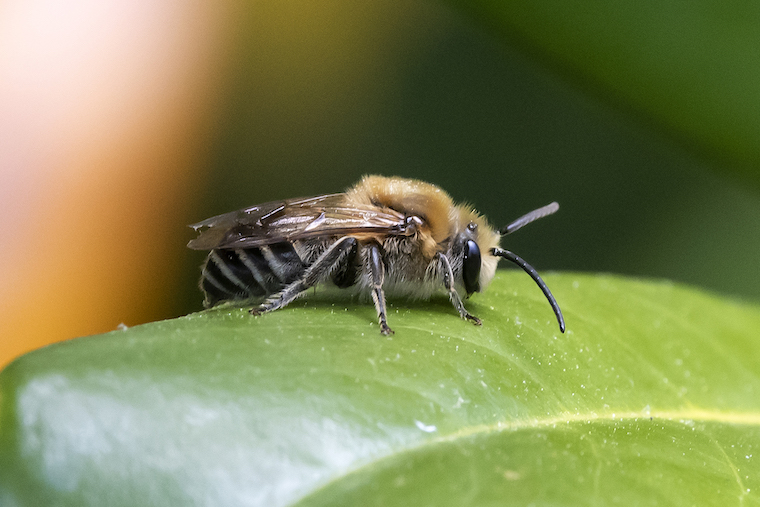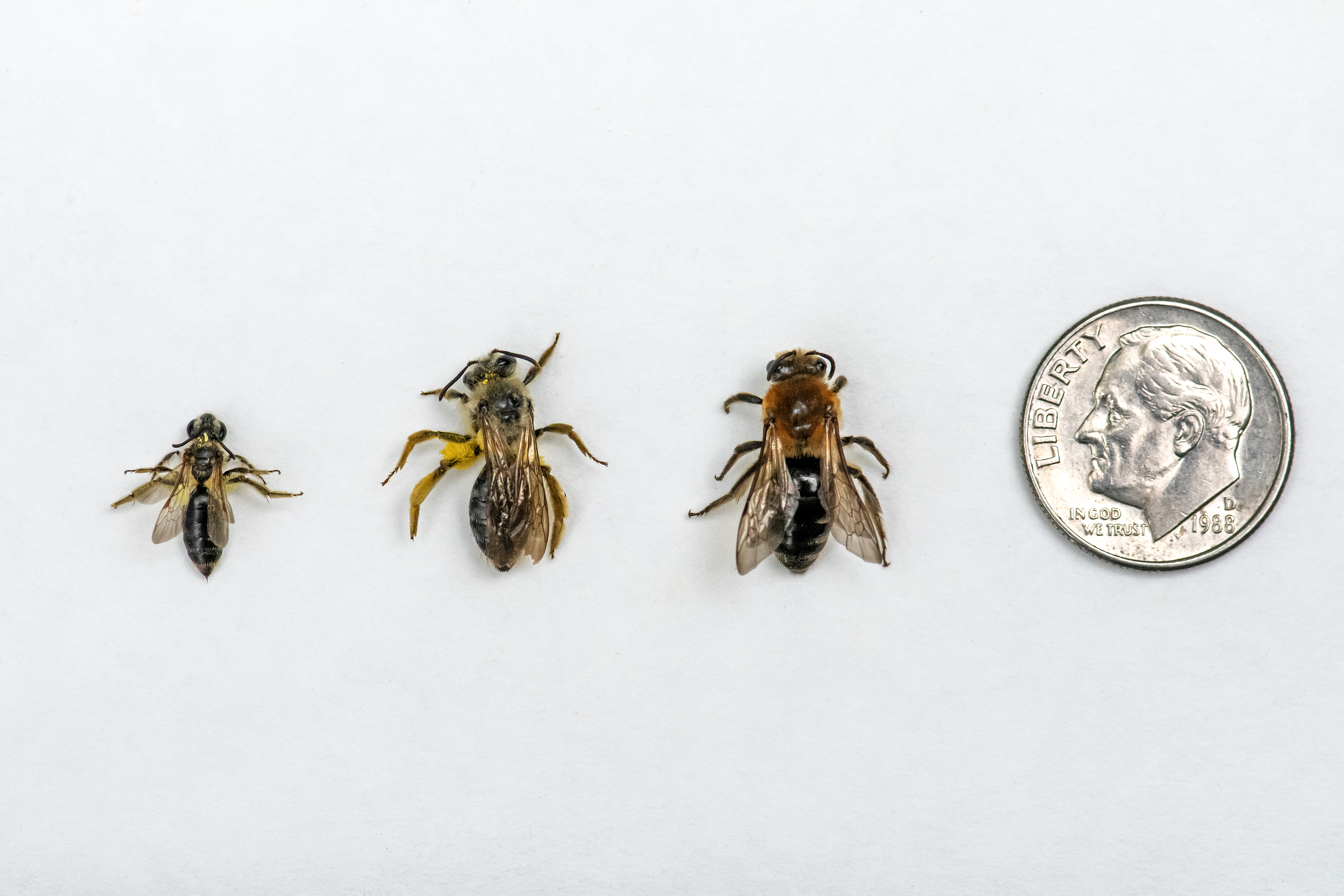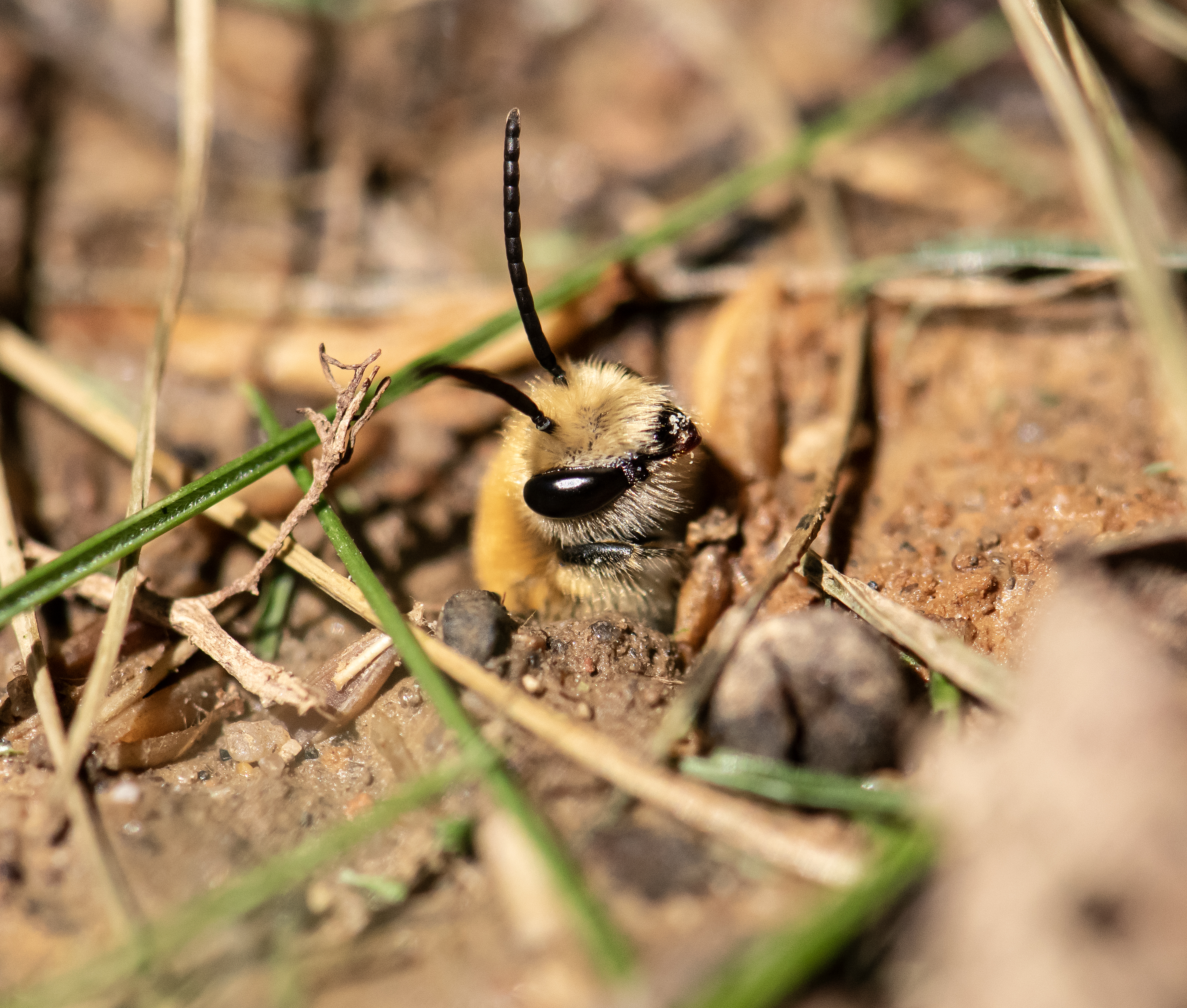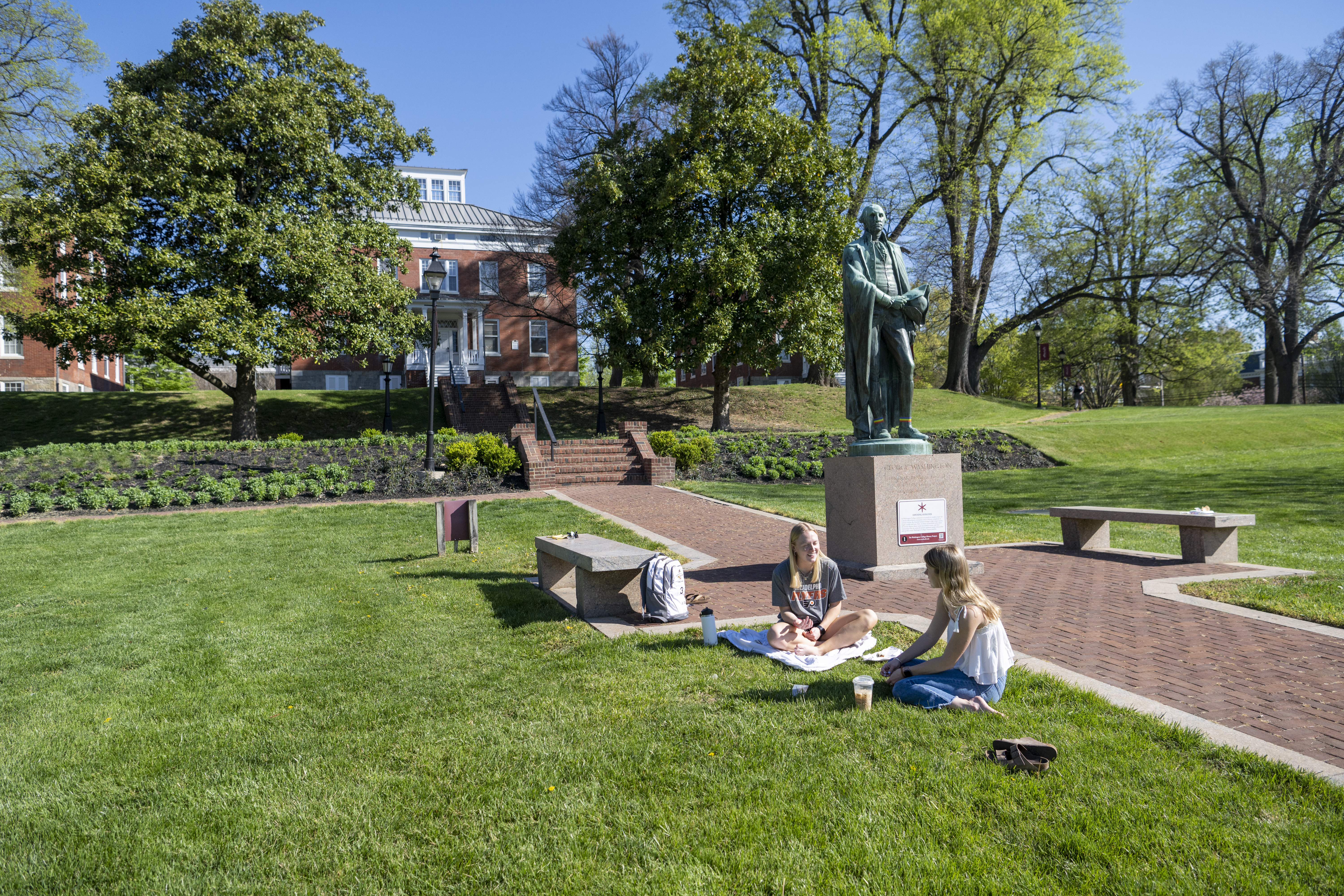Rare, Thriving Native Bee Nesting Site Documented on Campus
College photographer’s hobby leads to interest from Cornell University researchers

Ahead of World Bee Day on Monday, May 20, Washington College is buzzing with excitement about a unique and newly documented population of native bees on its campus. Although the large group of ground-nesting bees has been noticeable on one corner of campus for years, recent identification of at least five different species using the same area has sparked interest from researchers.
The section of the college green located in front of East and Middle Halls is a hotspot for these vital pollinators, with ground-nesting mining bees from the Andrena and Colletes genus thriving on the hill at the base of the Halls. Recently, thanks to her keen eye and love of insects, College photographer Pamela Cowart-Rickman realized that the area has multiple species of native mining bees all nesting together. Typically, communal nesting in aggregations has not been well documented.
Cowart-Rickman, who studied biology as an undergrad and developed a love of insects while working on her MFA in design, has tentatively identified five different species, all sharing the same nesting grounds - four different Andrena (mining bees), one Colletes (cellophane bees), and likely three cuckoo bees in the genera Nomada. Sam Droege at USGS Bee Lab assisted with the identification.
“The Washington College site provides rare nesting habitat for multiple native bee species, several of which are uncommon and unidentified. We always talk about providing plants to support native bees and other pollinators, but we rarely think about providing adequate nesting habitat for their survival. These native bees provide beneficial pollination to fruiting trees and plants, not only on the College campus, but also the Chestertown community,” stated Droege.

“They have been nesting amongst and on top of each other for several years in this same location,” said Cowart-Rickman of the bees she has spotted. “The various Andrena have the largest nesting area and emerge first in late February. The Colletes have a smaller area and emerge later in late April.”
From Hobby to Discovery
 Spending her days photographing the goings-on and highlights of Washington College
life for the school's marketing and communications department, Cowart-Rickman devotes
her free time to photographing insects and has been helping researchers identify and
track populations through her photos since the Covid lockdown. She has found and documented
several species for MD Biodiversity, BugGuide, iNat, and researchers at the Canadian
National Collection of Insects. When she realized what she had stumbled upon right
outside her own office building on campus, she reached out to Dr. Beth Choate, deputy
director of the Washington College Center for Environment and Society. Choate, who has published research on the abundance of wild bee populations in urban
and rural gradients, was also intrigued by the nesting sites Cowart-Rickman had found.
The two decided to investigate further.
Spending her days photographing the goings-on and highlights of Washington College
life for the school's marketing and communications department, Cowart-Rickman devotes
her free time to photographing insects and has been helping researchers identify and
track populations through her photos since the Covid lockdown. She has found and documented
several species for MD Biodiversity, BugGuide, iNat, and researchers at the Canadian
National Collection of Insects. When she realized what she had stumbled upon right
outside her own office building on campus, she reached out to Dr. Beth Choate, deputy
director of the Washington College Center for Environment and Society. Choate, who has published research on the abundance of wild bee populations in urban
and rural gradients, was also intrigued by the nesting sites Cowart-Rickman had found.
The two decided to investigate further.
“On a nice day in the spring, you can see the male bees hovering right at grass level. There were hundreds of these males searching for a female to mate when we were out there,” said Choate.
Females create a small burrow in the ground for rearing young and a ball of pollen and nectar is placed in each to feed the larval bee when it emerges from the egg, Choate explained. Once the males and females mate, the female returns to her nest and lays the egg in the carefully constructed burrow to develop.
“Ground-nesting bees need bare, minimally covered ground in order to dig into the soil. They also prefer sunny and well-drained soil, but it will be interesting to learn what is unique about the soil in this space and why the aggregation has become so large,” said Choate. “Since ground-nesting bees are solitary and do not form colonies, they generally aren't as noticeable as this aggregation. Females often create nests near one another; however, an aggregation this large is unique.”

After seeing one of Cowart-Rickman's nesting bee photos on iNat, and realizing the rarity of the site, Dr. Jordan Kueneman, a researcher with Project GNBee who is working on tracking ground-nesting bees at the Danforth Lab at Cornell University, reached out to Cowart-Rickman about possibly providing further research samples and information.
“We were very excited to learn about the ground-nesting bee aggregations at Washington College, for a myriad of reasons,” said Kueneman. “First, the size of the aggregation is substantial, and multiple species are utilizing areas of the overall site to nest. This scenario is ideal for understanding nesting requirements for bees and how those vary by species. Second, intermixed aggregations of nesting bees are particularly interesting to study from an ecological perspective, as the cost/benefits of varying nesting strategies and behavior can be more easily studied, particularly in the context of phenology, nest architecture, and risk of parasitism.”
Kueneman's project hopes to provide education and awareness of ground-nesting bees, who are, as he notes, “a vital and overlooked group of pollinators essential to terrestrial ecosystems.” The project aims to leverage local participatory actions to study bee nesting biology at scale, which can enhance ecosystem and agricultural sustainability by promoting resilient and diversified pollination services.
He noted that due to its location, the Washington College aggregation can easily provide the opportunity for students and the public to learn about the biology of ground-nesting bees and the value they provide to the environment. He is also hopeful that knowledge of the history of the area and the site's management can help inform how ground management practices on campus have impacted the population in the past and provide opportunities to explore how current management will impact this population in the future.
“Because of the size of the aggregation, the Cornell lab is interested in the type of soil in this location, so we gathered soil samples from nests throughout the aggregation in various locations,” added Choate.
Research and monitoring of the aggregation will continue as teams from both schools work together to study what makes this site so appealing to multiple species of bees.
Save the Bees!
A certified Bee Campus USA, Washington College has a long history of practicing and promoting conservation in and around its campus through its Natural Lands Project, beekeeping courses for students, food initiative internships and campus garden. One of its chemistry professors is also conducting research on new ways to potentially cure disease in honeybee hives.
Amidst all of this bee-focused activity, Cowart-Rickman has been impressed with how these solitary bees emerge each spring, creating a busy scene as they pollinate fruit trees, flowers, shrubs, and native maples, amidst students walking to class and the nearby traffic of a busy road through the small town on Maryland's Eastern Shore.

“Since I was a kid, I've always been interested in the tiny things, the things no one notices,” said Cowart-Rickman, who documents her insect photography on Instagram. Now, that interest is leading to an effort to protect a unique population of her favorite creatures.
In general, Cowart-Rickman and Choate urge the local community to become educated and make efforts to encourage native bee populations to flourish.
“Become aware of native bee species, how they nest, and what they feed on,” urges Cowart-Rickman. “A lot of pollinators nest in dried leaves, hollow twigs, rotting wood, and rough stone. Instead of burning these things in the fall, move them to an out of the way space until late spring. If you find a ground-nesting bee area don't destroy them. They are above ground for only a short time. Plant native plants and create meadows instead of lawns.”
Choate also encourages less mowing and less structure to gardens to encourage native bees to feel welcome. “Avoiding fertilizers, herbicides and pesticides will go a long way in encouraging native bee populations. Traditional lawn “weeds” such as clovers are a favorite for many bee species. And since many native bees nest in the ground, avoiding manicured beds that require mulching and supporting less managed, wildflower plantings in your yard will provide habitat for nesting and a plethora of food for pollinators.”
Kueneman urges those interested in protecting bees to help out ProjectGNBee. “Researchers at Cornell are seeking your help to better understand and protect the nests of solitary, gentle, ground-nesting bees. Even though 90 percent of bees are solitary and 70 percent of bees nest in the ground, knowledge about solitary ground-nesting bees is lacking,” he notes. “Our project will study how factors like soil characteristics affect these bee populations, which will help us learn how to protect and improve nesting habitat for bees that provide crucial pollination services. By promoting nesting sites for native bees, we can enhance ecosystem and agricultural sustainability and resilience.” You can participate in this community science project by joining Project GNbee's iNaturalist project here.
- Dominique Ellis Falcon